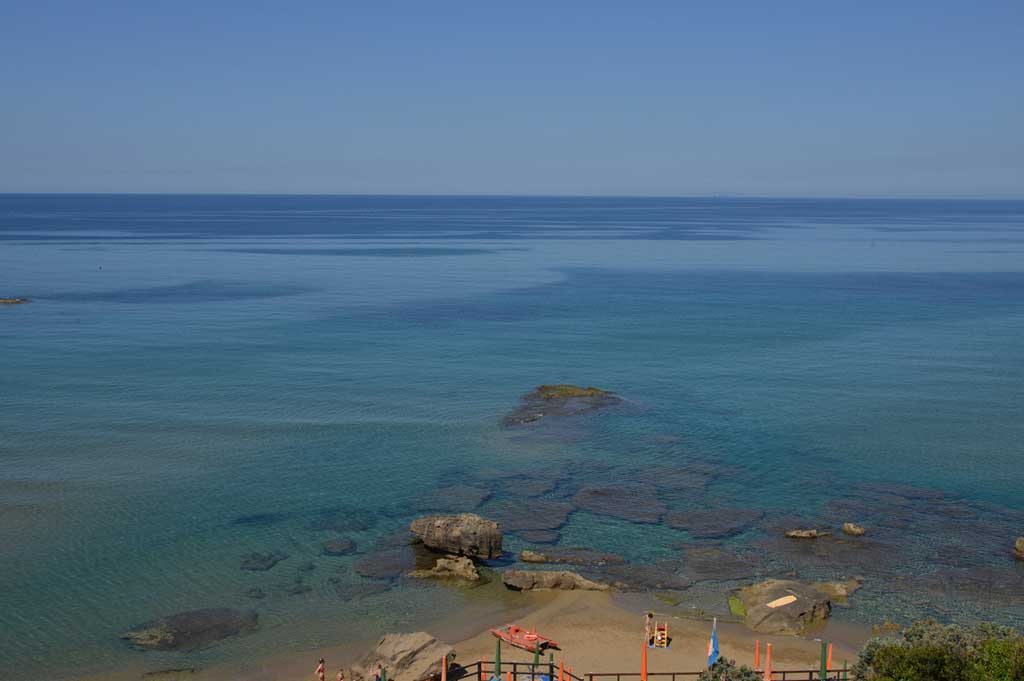Planning a trip but unsure when is the best time to visit Tuscany?
Read on for a month-by-month guide to Tuscany’s weather, major events in Tuscany and to find out how busy Tuscany is through the year.
Tuscany in January
While the rest of the world enjoys Dry January and juice cleanses, Tuscany continues to celebrate the holidays with feast of the Epiphany. Despite being one of the quietest months to visit, there is still plenty to see, do and eat, as well as sunshine to enjoy.
Tuscany weather in January
January is the coldest month to visit with a typical daytime high of 10℃ (50℉) and a low of 3℃ (37℉) overnight.
Snowfall and cold snaps are common towards the end of the month — Tuscans call these “giorni della merla” (blackbird days). An old tale recounts how January was outraged by the blackbirds complaining about the winter, and borrowed 3 of February’s days. He made them the harshest and coldest days of all months.
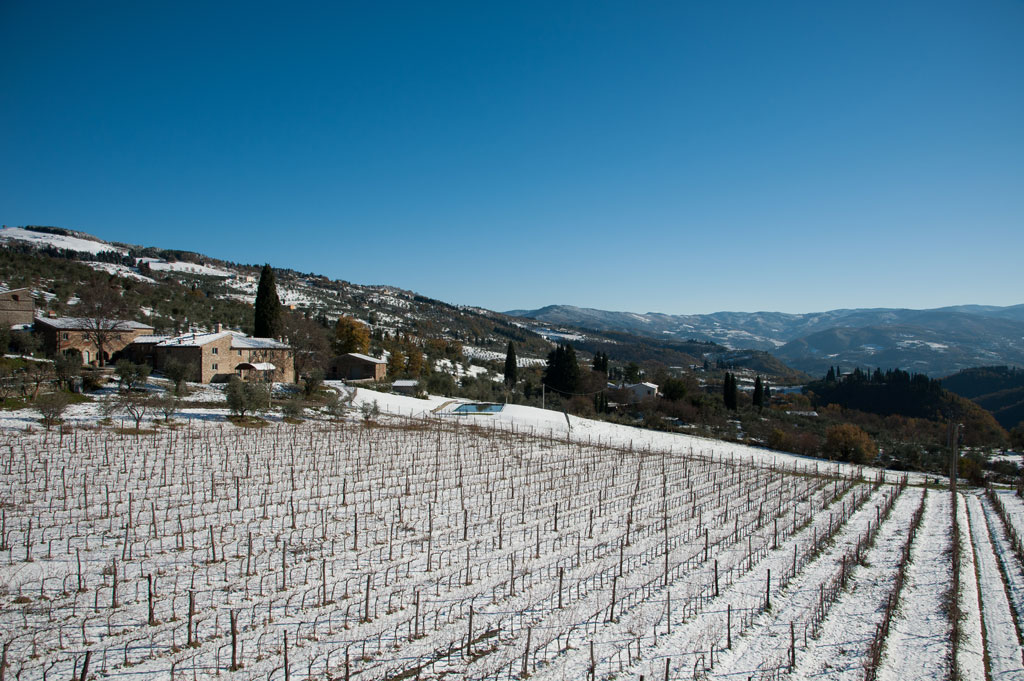
The Estate of Petroio, snow-covered fields
How busy is Tuscany in January?
Winter in Tuscany is low season for tourism. With fewer crowds you may not need to book activities ahead. You can easily find a table at renowned trattorias and restaurants which are either fully booked or closed all summer, such as La Bottega del Buon Caffè in Florence, Bistrot in Forte dei Marmi and Osteria di Passignano in Badia a Passignano.
What’s on in Tuscany in January?
Epiphany is a national holiday in Italy. Florentines celebrate with the Cavalcata dei Magi, where participants dress in medieval costume and wind their way around the streets of Florence singing and dancing.
Towards the end of the month one of Tuscany’s longest-running horseraces, the Palio di Buti, takes place. While the traditional Palio routes are circular, this race runs in an S-shape.
A glass of juice made from Sicilian blood-oranges — in season each January — will give your immune system that extra boost it needs to survive the winter.
Like everywhere in Italy, the first Sunday of the month is also free admission to state-owned museums (Uffizi, Bargello and others) and archaeological sites.
Tuscany in February
As one of the quietest months, February is a good time to book a romantic getaway in one of our Tuscany villas. With fewer tourists, you can explore cities such a Florence, enjoy a gondola ride along the Arno, and feast at any Michelin-starred restaurant of your choice.

Gondola Ride along the Arno
Make sure to pack a fancy dress costume, because this is also Carnival time.
Tuscany weather in February
Tuscans live February through the old saying, “Per la Candelora, dell’inverno siamo fora, ma se c’è sole o solicello siamo a mezzo dell’inverno”. If there is sunshine or sunny intervals on February 2nd, also known as Candlemas, then winter is still not over.
February can be one of the coldest months of the year. Expect a typical daytime high of 13℃ (55℉) and a low of 3℃ (37℉) overnight
How busy is Tuscany in February?
The Tuscan coast can get busy during Carnival, but the rest of February is still relatively low season for tourism.
If you are planning a romantic holiday for two, you may not need to book activities ahead of time. You can easily find a table at Michelin starred restaurants which are either fully booked or closed all summer, such as La Bottega del Buon Caffè in Florence , Bistrot in Forte dei Marmi and Arnolfo in Colle di Val d’Elsa.
What’s on in Tuscany in February?
Carnevale di Viareggio is one of Europe’s renowned carnivals. If you are staying in a villa near Pisa or Lucca, visit the seaside town Viareggio on any of 4 consecutive weekends for partying, costumes and float parades.
Cenci are traditional sweets prepared during Carnival made with fried puff-pastry and topped with powdered sugar. Pasticceria Patalani is one of the best bakeries in Viareggio.
Like everywhere in Italy, the first Sunday of the month is also free admission to state-owned museums (Uffizi, Bargello and others) and archaeological sites.
Tuscany in March
After 3 consecutive months’ celebrating, Tuscany enjoys a month of relaxation. Despite no large festivities taking place, those with a healthy appetite or an eye for medieval games will be entertained by a flurry of smaller, local events.
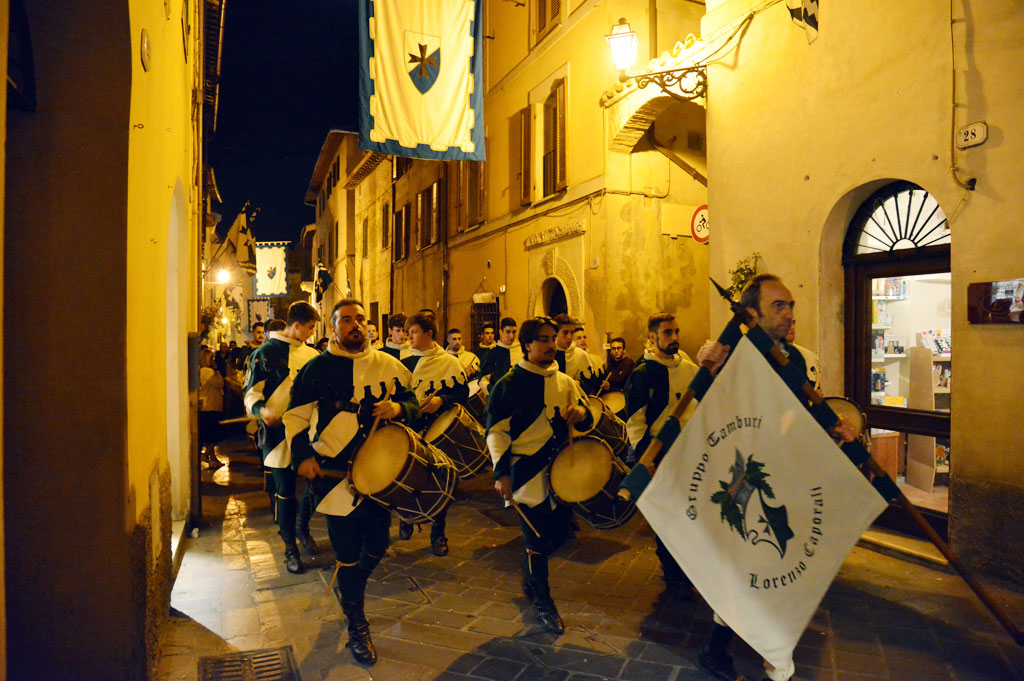
San Gemini, Medieval Games
Tuscany weather in March
The weather in March fluctuates between rain and blue skies, so keep an umbrella handy.
Expect an average daytime high of 16℃ (60℉) and a low of 6℃ (42℉) overnight.
How busy is Tuscany in March?
The end of winter is still low season for tourism. With fewer crowds and warmer temperatures, you can enjoy activities like a countryside Fiat 500 Tour or a Hot Air Balloon Flight over Tuscany, which may be either booked up or too hot to fully enjoy in high summer.
What’s on in Tuscany in March?
March 8th is International Women’s Day. As a sign of respect and solidarity, Italians gift the women in their life a yellow mimosa flower. Artichokes are in season from March to May. They make beautiful flowers as well as a delicious dish, sauteed or fried. Keep an eye out for Carciofi alla Toscana and Carciofi Fritti.
Two fairs dedicated to food and wine take place in March: Taste (Florence) focuses on food, wine, objects and ideas that rule contemporary Italian culture; and Terre di Toscana celebrates the wine areas and DOCs of the Tuscan region.
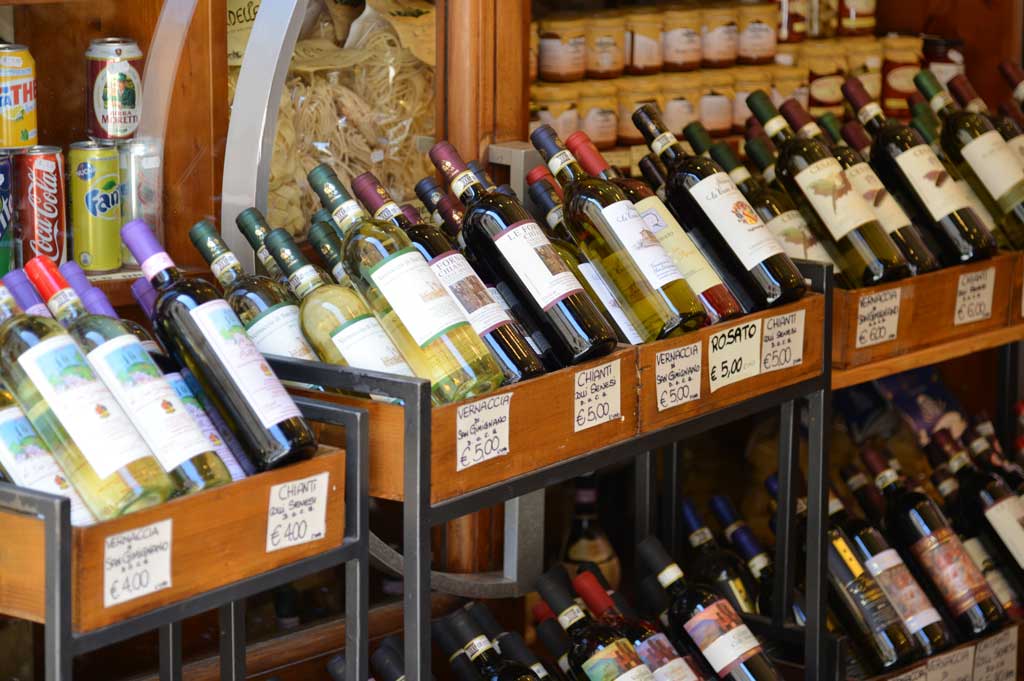
Wine, Tuscany market
Palio dei Somari is a medieval race held in Torrita di Siena, with donkeys instead of horses. Expect medieval dances, flag-throwing, parades and banquets.
On the first Sunday of the month state-owned museums (Uffizi, Bargello and others) and archaeological sites in Italy offer free admission.
Tuscany in April
A sweet tooth and a set of earplugs is enough to hop on a flight to Tuscany in April. While the rest of the world celebrates Easter with chocolate eggs, Tuscans add sweet breads and an exploding cart to the mix.
You can burn off the extra calories in the Tuscan countryside. Make sure to bring a camera, because the arrival of Spring brings wild poppies, roses and marguerite daisies.
Tuscany weather in April
The Tuscans survive April with the local motto (and umbrella): “Terzo aprilante, quaranta giorni durante”. If it rains on April 3rd, rain will continue for another 40 days.
Temperatures are still not yet bikini-friendly. Expect a daytime high of 19℃ (66℉) with a low of 8℃ (46℉) overnight.
How busy is Tuscany in April?
Easter weekend in Tuscany is packed, but the rest of April is still relatively low season for tourism. If you come over the holiday weekend, we recommend you book major museums (especially the Uffizi), restaurants, wine tasting and cookery classes in advance.
What’s on in Tuscany in April?
Prepare yourself for the loudest event of the month: Scoppio del Carro. The folklore Easter Day tradition features 150 white oxen, a 30-ft. an antique cart filled with fireworks and one very big explosion.
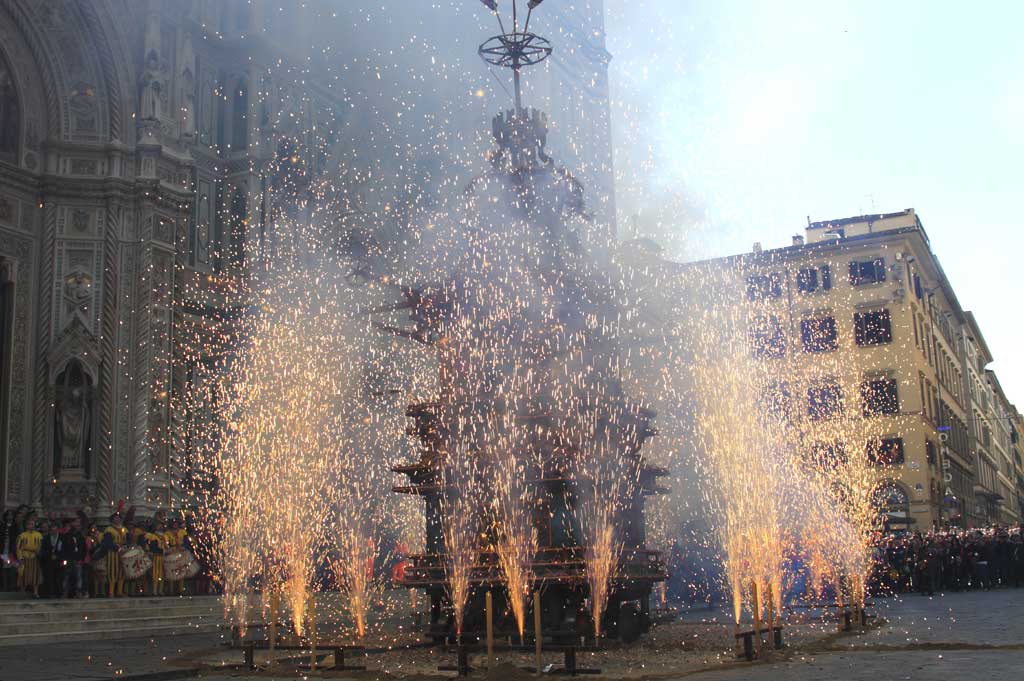
Scoppio del Carro
Celebrate Easter with chocolate eggs and a traditional Colomba di Pasqua, sweet bread similar to Panettone baked into the shape of a dove.
Sinalunga (south-east of Siena) host one of Italy’s sweetest festivals: Sagra del Ciambellino. The mini-donut is best enjoyed soaked in Vin Santo, coffee or cappuccino.
Don’t forget that on the first Sunday of the month, state-owned museums and archaeological sites in Italy offer free admission.
Tuscany in May
May is a great time to visit Tuscany, right before the peak season begins. Experience the Tuscan summer without scorching temperatures and crowds. May also features many different outdoor events and activities.
Evenings are warm enough to enjoy a glass of wine below the pergola of your Tuscany villa.
Tuscany weather in May
May is a warm and sunny month, with a typical daytime high of 25℃ (77℉).
Make use of longer days to explore the outdoors, but carry a light jacket as temperatures drop as low as 12℃ (53℉) overnight.
How busy is Tuscany in May?
May is a great month to visit Tuscany before peak season really gets going. With various festivals and events taking place, we recommend booking everything ahead of time (our concierge service can help).
What’s on in Tuscany in May?
Two major wine events are staged in May. Mostra del Chianti is dedicated to the traditions, practices and culture of Chianti wine. Cantine Aperte is one of Italy’s most important wine tourism events. Wineries all across Italy open their cellar doors to the public. Read up on Italian wine — written by our local experts.
Wine may not count as one of your 5-a-day, but cherries do! Cherries are in season (and are said to have antioxidant properties). A portion of 15 counts as one of your 5-a-day.
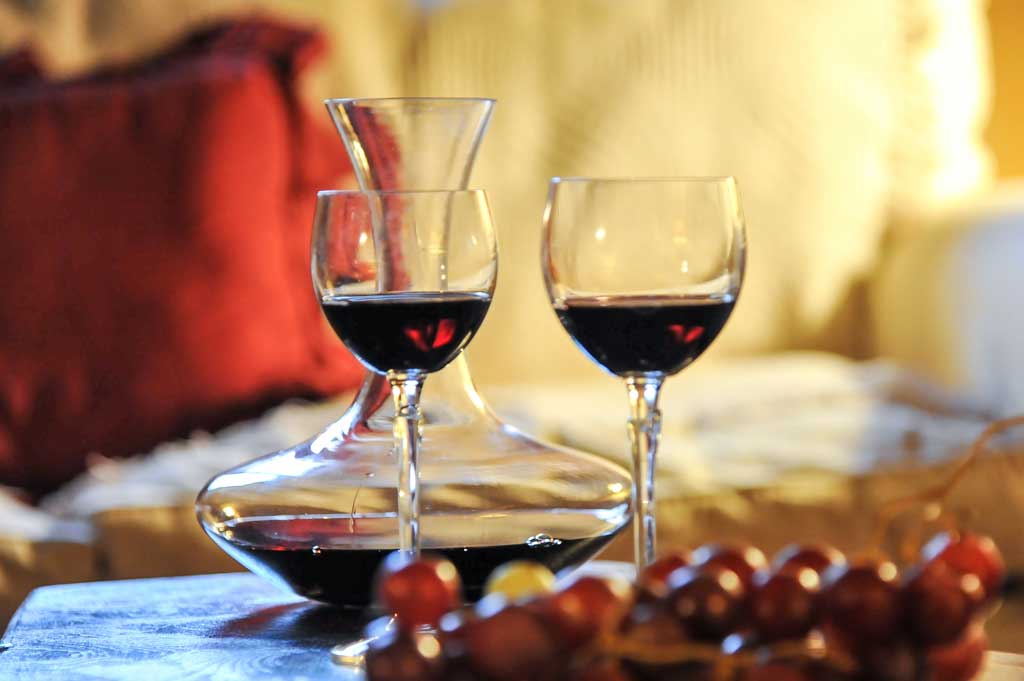
Chianti wine
Maggio Musicale is one of the oldest classical musical festivals in Europe. Concerts, opera and ballet performances are staged all around the historic centre of Florence.
Barberino Val’d Elsa blossoms each May for “Barberino in Fiore”. Over one weekend, this fortified little town fills with stalls selling local flowers, food, wine, and art — dedicated to the skills, traditions and creativity of Chianti.
Every year in mid-May it’s Night of the Museums across Italy. Museums remain open past midnight, offering free admission or reduced prices. If you miss this chance, don’t forget the first Sunday of the month, when state-owned museums (Uffizi, Bargello and more) and archaeological sites offer free entrance for everyone.
Tuscany in June
Summer has officially arrived! Tour buses, flip-flops and the drifting smell of sunscreen signal the beginning of high season. Outdoor events take place all over Tuscany, so bring a hat.
Tuscany weather in June
June is a great time to get outdoors before temperatures hit their summer peak. Expect a daytime high of 27℃ (80℉) and a low of 15℃ (59℉) overnight.
How busy is Tuscany in June?
Summer in Tuscany is high season. We recommend booking all activities in advance, including making restaurant reservations. You may prefer to dedicate more time to relaxing by the private pool in your villa in Tuscany.
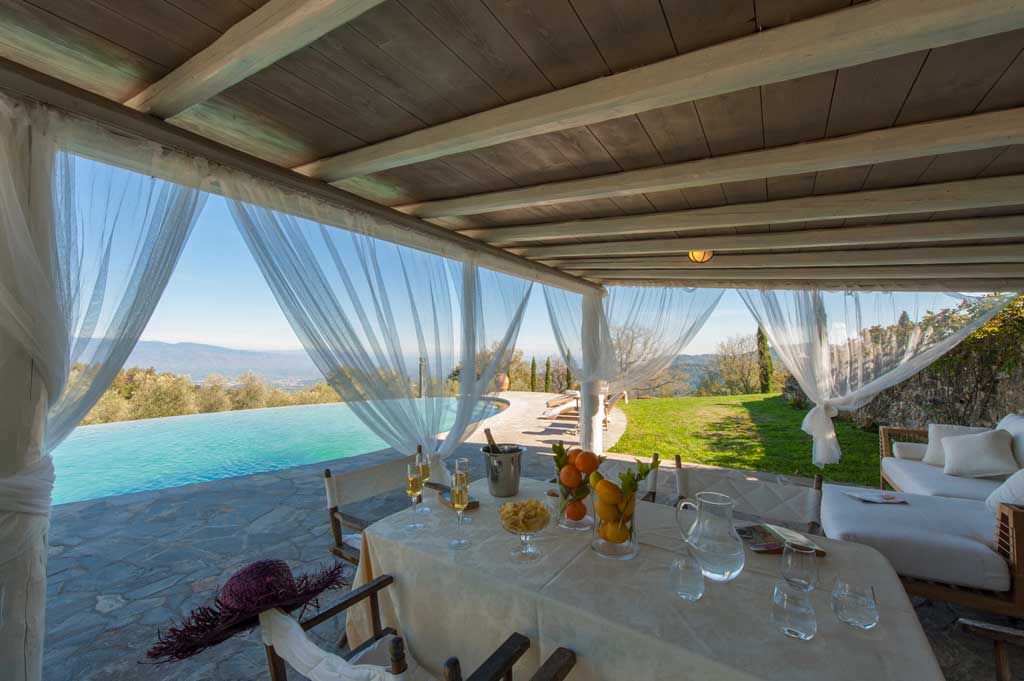
Il Cortile Pratolino, Shaded pergola with seating and dining area by the pool
What’s on in Tuscany in June?
On June 2nd Italy celebrates the Festa della Repubblica. This marks the official abolition of the Monarchy and formation of the Italian republic. Celebrations take place all over the country.
Pisa hosts 2 big events this month. The Luminara di San Ranieri includes a regatta contested by the city’s 4 ancient neighbourhoods in honour of their patron, San Ranieri. The Gioco del Ponte is a medieval battle of strength on Pisa’s oldest bridge.
In June Florence hosts the renowned Calcio Storico. This early form of football is played between Florence’s 4 traditional neighbourhoods. It’s historic, ruthless and not to be missed.
You can also join the city in celebrating Corpus Christi. A procession begins in Piazza del Duomo and ends in Piazza Santa Trinita with street celebrations and festivities.
Escape the sun and stop by any state-owned museum or archeological site on the first Sunday of the month for a free visit.
Stay hydrated with the seasonal cantaloupes. As a snack, or paired with prosciutto as an antipasto, cantaloupe melon is hydrating, refreshing and sweet.
Tuscany in July
July in Tuscany is one of the busiest and warmest months. Hot summer calls for a cool pool, a cooking class or a Chianti Wine Tour.
For music aficionados there’s a trio of treats in Fiesole, Montalcino and Torre del Lago. If you are staying in a Villa near Siena, don’t forget to pick up scarf colours for Tuscany’s most anticipated horserace of the year — the Palio di Siena..
Tuscany weather in July
July is one of the hottest months of the year with a typical daytime high of 30℃ (86℉) and a low of 18℃ (64℉) overnight.
You will avoid the most intense heat if you explore outdoors in the early mornings and late afternoons.
How busy is Tuscany in July?
Summer in Tuscany is high season — and July is the busiest month of the year. Expect crowds close to major sights in cities like Florence and Siena.
Book all activities and restaurants in advance — or ask our travel concierges to do it for you.
What’s on in Tuscany in July?
The first annual staging of Italy’s most famous horse race, the Palio di Siena takes place in July. Supporters from all over the world gather in Piazza del Campo to watch 10 of Siena’s 17 neighbourhoods compete against one another. The celebration begins with a historical procession at 3pm which winds through the city centre, followed by the race at 7:30pm.

Palio di Siena, Piazza del Campo
Tuscany is renowned for wild boar. Its rich and succulent meat tastes divine with pasta or as a stew. On the first Sunday of the month, residents of Gavigno celebrate the wild boars that roam their valley with their annual Wild Boar Festival.
The annual Puccini Festival stages works by Italian composer Giacomo Puccini, a native of Lucca. A specially built open-air theatre beside Lake Massaciuccoli is open from July till the end of August — and a must for all opera fans.
The Jazz & Wine Festival in Montalcino is the place to enjoy blockbuster red wine Brunello di Montalcino, washed down with some local jazz. Estate Fiesolana is a festival of classical music and theatre at venues around Fiesole, including the town’s ruined Roman amphitheatre. It is a great way to escape the heat of Florence.
And don’t forget, all state-owned museums and archeological sites in Italy are free to enter on the first Sunday of every month.
Tuscany in August
August is the hottest month of the year. Locals flock to the mountains and Tuscany’s best beaches, so cities like Florence are given over to tourism. The sights and beauty remain unchanged.
If you’re not lounging by the private pool in a Tuscany villa, then you might like to hit Siena for the second annual staging of its famous pageant, the Palio di Siena.
Tuscany coast, maremma, beaches
Tuscany weather in August
August is the hottest month of the year with a daytime high of 32℃ (89℉) and overnight low of 20℃ (68℉).
How busy is Tuscany in August?
Summer in Tuscany is high season. Book all activities and restaurants in advance, or ask our dedicated travel concierges to do it for you.
What’s on in Tuscany in August?
The second annual Palio di Siena takes place on August 16th. Like July’s race, this edition includes representatives from seven neighbourhoods which didn’t race in the previous year’s Palio plus another three drawn from the hat. Even the draw is a major event, and fills the Campo with a mix of contrada members and curious tourists.
During the race itself, the first horse to run three laps around the Campo — with or without its jockey — wins the hand-painted silk banner, the Palio — sometimes known as the Drappellone.
Eating a slice of watermelon is one trick to cope with the heat — on Palio day or at any other time in August. At the Watermelon Festival (last weekend of August) in Castellina in Chianti, you get to enjoy an abundance of watermelon, live music and dancing.
Alongside its fine wine, Montepulciano is renowned for a medieval competition which takes place at the end of August. The Bravio delle Botti involves racing uphill for a mile pushing giant wine barrels.
Enjoy a free visit to any state-owned museum or archeological sites on the first Sunday of the month. They are all air-conditioned!
Tuscany in September
While the rest of the world returns to reality, Tuscans continue to indulge their summer. The weather remains favourable for visitors.
During September in Italy, you can explore historic festivals in three charming cities, including a cheese fair, a candle-lit procession and a street procession.
Tuscany weather in September
Summer may be over, but the weather in Tuscany is still warm. We do recommend you pack a light jacket for the evening.
Expect a typical daytime high of 27℃ (81℉), and a low of 17℃ (62℉) overnight.
How busy is Tuscany in September?
September in Tuscany is shoulder season for tourism. With fewer crowds around, you may not need to book activities ahead of time.
Many restaurants which close over the summer reopen, so book in advance or ask our travel concierges to make table reservations for you.
What’s on in Tuscany in September?
Festa della Rificolona is the oldest festival in Florence. If you are staying in one of our villas near Florence, head into the city centre for street performances, live music and food stalls. Those really in-the-know bring their own papier-mâché lantern to the street procession.
Lucca hosts a sacred candle-lit procession as part of its religious festival, the Luminara di Santa Croce. Following the parade, there’s a concert inside the Cattedrale di San Martino followed by fireworks. The town walls in the San Frediano neighbourhood usually provide the best vantage point.
Pienza is known for its pecorino sheep’s milk cheese and streets of love. Every year they honour their local cacio (cheese) with the Festa del Cacio. The festival concludes with a folkloric game where competitors have to roll a cheese wheel at a target.
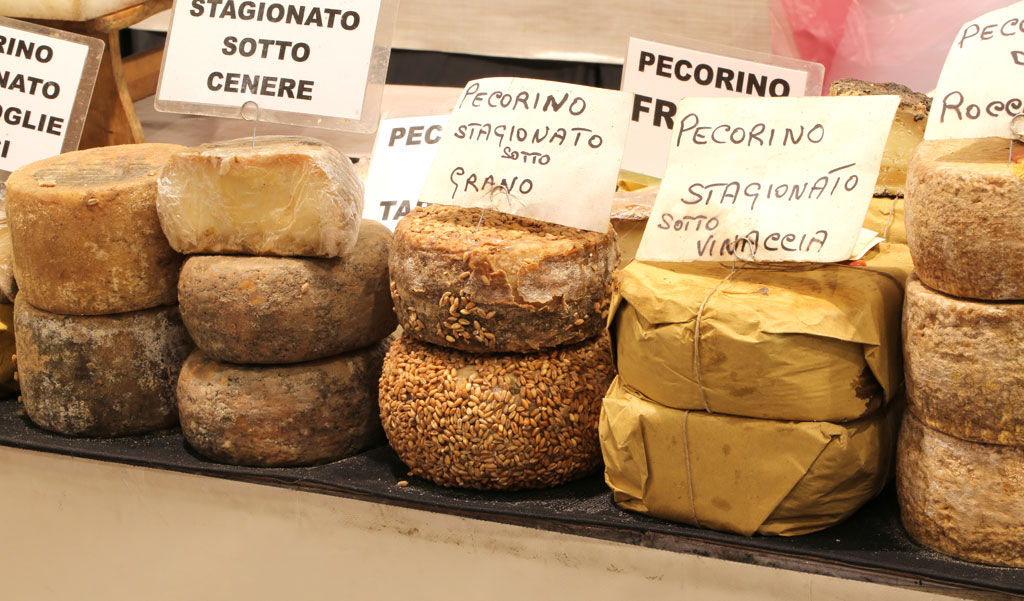
Pecorino cheese
Pecorino is especially delicious paired with figs. This seasonal flower — not fruit (!!) — can be enjoyed raw or made into a cheese-friendly compote.
Like everywhere in Italy, the first Sunday of the month is also free admission to state-owned museums (Uffizi, Bargello and others) and archaeological sites.
Tuscany in October
Summer has come to an end, but don’t let that stop you enjoying a holiday in a luxury villa in Tuscany. Bask in some much needed R&R by your private pool, weather permitting. (If it doesn’t, we have villas in Italy with heated pools and spa villas in Italy.)
Two big outdoor events take place in October, so bring your trainers.
Tuscany weather in October
Autumn in Tuscany is characterized by sunshine and blue skies. Expect a daytime high of 22℃ (72℉) and a low of 11℃ (52℉) overnight.
How busy is Tuscany in October?
Autumn in Tuscany is the start of low season for tourism. With fewer crowds around, you may not need to book activities ahead and can easily find a table at sought-after restaurants like La Bottega del Buon Caffè in Florence or Osteria di Passignano, close to many of our Chianti villas.
What’s on in Tuscany in October?
It’s just €10 to participate in Certaldo’s Boccaccesca Festival. This pretty medieval Tuscan town lures food and wine fanatics each year with cooking classes and tastings.
In southern Tuscany, Montalcino hosts its own food festival dedicated to a local delicacy, il tordo (thrush). This songbird is now protected (and no longer on the menu), but you can still feast on local dishes like wild boar.
Keep an eye out, pretty much everywhere, for chestnuts. Roasted, boiled, baked in cakes or mashed into a puree, it is a seasonal treat.
Discovering beauty outdoors is another big theme for October in Tuscany. You can explore Chianti’s backroads during the historical cycling event, L’Eroica, or head to the Tuscan coast for the annual Historical Sailing Boat Gathering, where around 100 historic boats race.
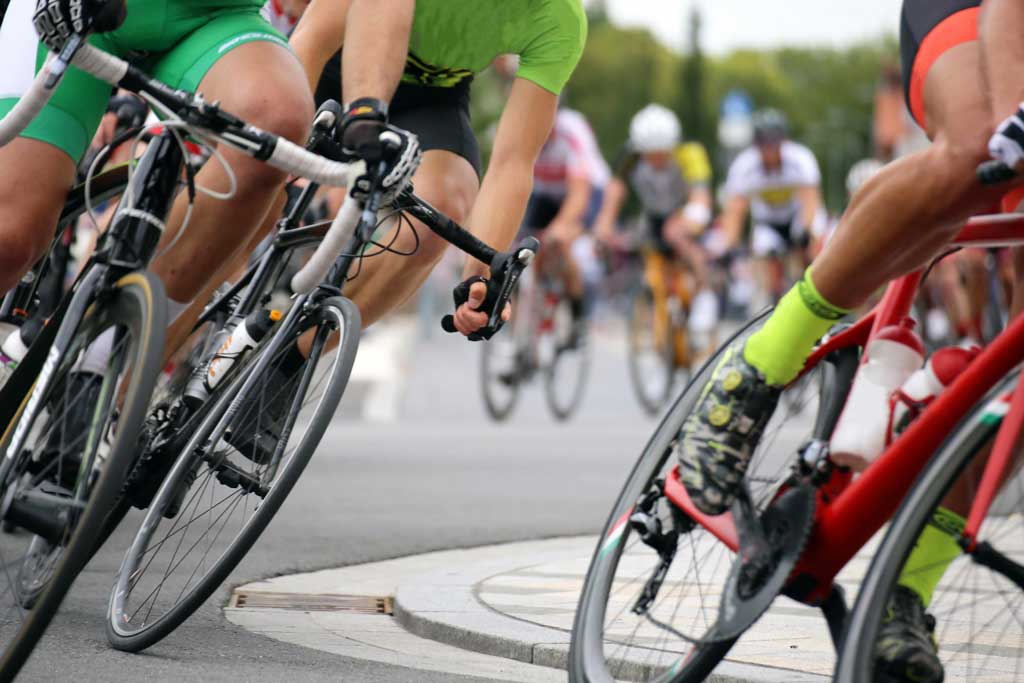
L'Eroica
Plus, there is free entry to state-owned museums (Uffizi, Bargello and others) and archaeological sites on the first Sunday of the month.
Tuscany in November
It’s easy to lose your grip on the #healthylifestyle when surrounded by the best food and wine in Italy. If pappardelle al cinghiale (pasta with wild boar sauce), bistecca alla fiorentina (flamegrilled beef on the bone) and pappa al pomodoro (thick fresh tomato soup) are not enough, a famed seasonal delicacy returns each November: white truffles.
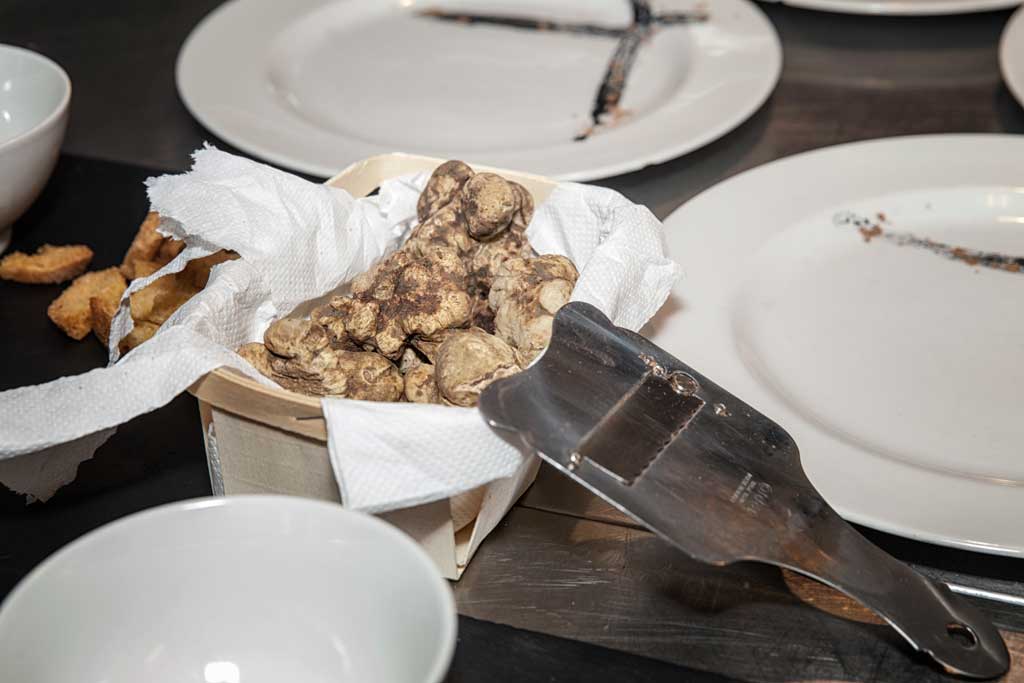
White truffles
Lucky for you, one of Europe’s most scenic marathons also takes place in Florence this month. Pack your running shoes. Who says you can’t have your cake and eat it?
Tuscany weather in November
Temperatures drop with the onset of winter. Expect a daytime high of 16℃ (60℉) and a low of 7℃ (44℉) overnight.
With the weather generally cool and damp, November is the ideal month to enjoy a wine tasting or cooking class at your villa in Tuscany.
How busy is Tuscany in November?
Late autumn in Tuscany is low season for tourism. With fewer crowds you should rarely need to book seasonal activities like truffle hunting, or even restaurants. Our concierge team can arrange it all.
What’s on in Tuscany in November?
November begins with a national holiday: Ognissanti, All Saints’ Day. Traditionally Italians attend mass, followed by a long lunch.
You can experience this holiday like a local and indulge in two traditional sweet breads: Schiacciata dei Santi – crispy, thin focaccia with raisins, figs and walnuts – and Castagnaccio, a bread made with chestnut flour and garnished with pine nuts, raisins and rosemary.
Work off the carbs in one of the world’s top 20 marathons through one of the most beautiful cities in the world. Firenze Marathon passes through the historic centre of Florence close to all the major sights.
The last three weekends of the month are dedicated to San Miniato’s White Truffle Festival. You can learn about the history and culture of this prestigious fungus, and all the many ways to incorporate it in your cooking.
Like everywhere in Italy, the first Sunday of the month is also free admission to state-owned museums (Uffizi, Bargello and others) and archaeological sites.
Tuscany in December
December in Tuscany is a quiet month to visit. Days are short and colder, but Christmas lights and Vin Brûlé bring out plenty of local festive spirit.
Just like for every other special occasion, Tuscans don’t miss the opportunity to feast. Pack a big appetite as well as a warm wardrobe.
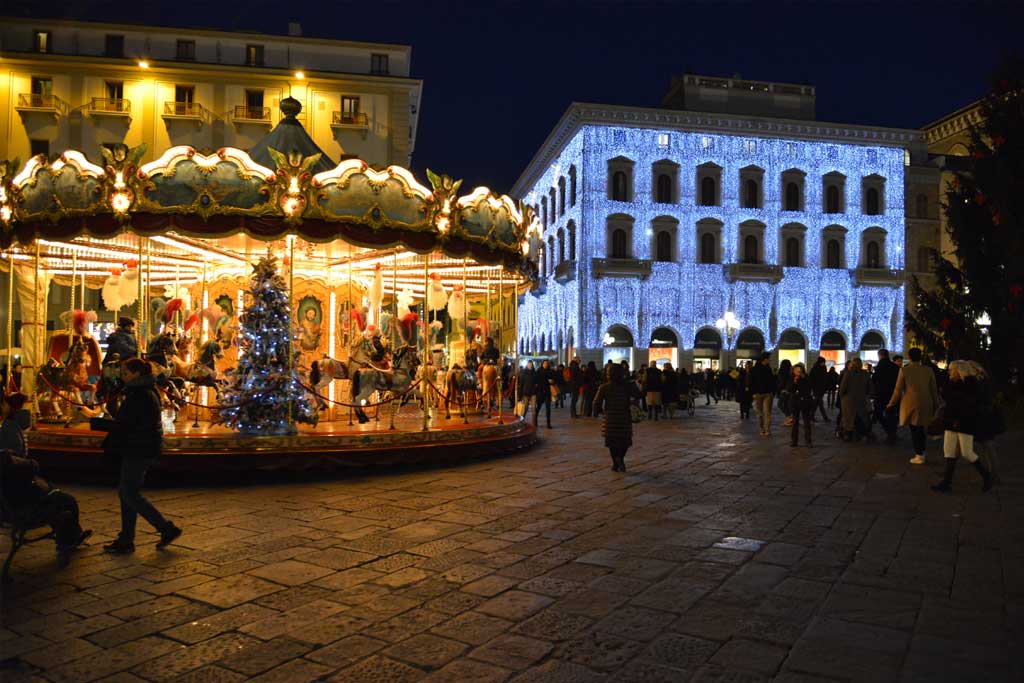
Christmas in Florence at night
Tuscany weather in December
December is a cold month to visit Tuscany. Expect a daytime high of 12℃ (53℉) and a low of 7℃ (44℉) overnight. It can get colder up in the hills of the Chianti and Maremma.
How busy is Tuscany in December?
Winter in Tuscany is low season for tourism. Escape the cold and join Tuscans as they feast their way through winter at many a local trattoria.
Book ahead of time to secure your table around major holiday dates — or ask our concierge team to arrange it all for you.
What’s on in Tuscany in December?
December 8th is a national holiday for the Immaculate Conception. Religious services and celebrations take place across Tuscany. In Florence the Christmas tree appears in Piazza del Duomo with a ceremony and concert. Every year a life-sized nativity scene with terracotta statues, created by the artisans of Impruneta, also decorates the cathedral square.
The biggest Christmas market in Tuscany is held in Piazza Santa Croce, Florence. The market draws on German traditions for its food, wine and crafts.
You can attend traditional Christmas Eve/Morning Mass at the Duomo, celebrated by the Cardinal of Florence.
No Christmas in Tuscany is complete without a slice of Panettone. This festive bread with candied fruit is best washed down with a glass of Vin Santo sweet wine.
Don’t forget the first Sunday of the month, when all state-owned museums and archaeological sites in Italy offer free admission.

